Griesmer Site facts for kids
Quick facts for kids Griesmer Site |
|
|---|---|
| Lua error in Module:Location_map at line 420: attempt to index field 'wikibase' (a nil value). | |
| Location | on the Kankakee River near Schneider, Indiana |
The Griesmer site (La-3) is an ancient place found near the Kankakee River in Lake County, Indiana. It's about a mile southeast of Schneider. This site is special because different groups of people lived there at different times in history, long before Europeans arrived.
Archaeologists call these different periods "occupations." At Griesmer, they found signs of people from the Middle Woodland (around 100 B.C. to 500 A.D.), Late Woodland (around 500 A.D. to 1500 A.D.), and Upper Mississippian (around 1000 A.D. to 1500 A.D.) times. Even though the layers of soil weren't perfectly stacked, experts used the types of tools and objects found, plus special dating methods, to figure out when each group lived there.
Contents
Digging Up the Past: Archaeological Investigations
Archaeologists from the Indiana Historical Society carefully dug up parts of the Griesmer site in 1962. This was a very important study. Sadly, just five years later, the site was completely destroyed. Sand was removed from the area, which meant this historical treasure was lost forever. This is why archaeological digs are so important: they help us learn about the past before it's gone.
What We Found: Results from the 1962 Dig
The 1962 dig at Griesmer uncovered many exciting things. They found special areas called "features," which are signs of human activity like old campfires or storage pits. They also found thousands of prehistoric tools and objects, as well as animal bones and plant remains. These discoveries help us understand how ancient people lived.
Features: Clues About Daily Life
Most of the special areas found at Griesmer were from the Upper Mississippian time. One old campfire (called a hearth) was found, but the other features were mostly pits. Here are the types of pits they found:
- Type A: Pits filled with trash (10 pits).
- Type B: Deep pits that were empty (8 pits).
- Type C: Deep pits with plant remains, including parts of white water lily plants. These were likely used for roasting food (49 pits).
- Type D: Deep roasting pits with layers of mussel shells on top (8 pits).
- Type E: A pit used to store valuable items, like special stone discs (1 pit).
Archaeologists also found 94 "post molds." These are marks left in the ground where wooden posts once stood. From these marks, they could tell that there were at least two ancient buildings at the site.
Animal Bones: What They Ate
The archaeologists found a huge amount of animal remains at Griesmer. They recovered over 4,700 animal bones and 8,193 mussel shells! This tells us a lot about what the people living there ate. The most common animal bones found were from turtles, deer, elk, and fish. This shows they were skilled hunters and gatherers, using the resources around the Kankakee River.
Artifacts: Tools and Treasures
Artifacts are objects made or used by people in the past. The Griesmer site yielded many different kinds of artifacts. These objects give us clues about the daily tasks people did, their ceremonies, games they played, and even their clothing or jewelry.
Here's a look at some of the main types of artifacts found:
- Pottery: They found 1,769 pieces of broken pots (called "pot sherds"). We'll talk more about these later.
- Chipped Stone Tools: There were 2,113 stone objects, with 301 of them being tools. These included 74 projectile points (like arrowheads), 16 knives, 7 smaller knives, 4 gravers (for engraving), 63 scrapers (for cleaning hides or working wood), 6 drills, and 2 blades.
- Ground Stone Tools: These are tools made by grinding and polishing stone. They found 5 of these, including a grinding stone, 2 tools for straightening arrow shafts, 5 hammer stones, and a mano (a hand stone used for grinding).
- Bone Tools: People also made tools from animal bones and antlers. They found 51 bone tools, including 3 antler projectile points, 5 hoes made from shoulder blades (4 from elk, 1 from bison), an antler pick, a deer skull spoon or scoop, a deer leg bone tool for working hides, 2 bone knives or scrapers, a beaver tooth tool, an antler tool for flaking stone, a bone flaker, 3 beads, and 5 antler cylinders that might have been game pieces.
- Pipes: They found one broken piece of a pipe shaped like a turtle head. People used pipes for smoking, sometimes in ceremonies.
- Copper Artifact: One small copper object was found, which might have been a tinkler (a small bell-like ornament) or a cone.
Some of the most interesting and important non-pottery artifacts are shown in the table below. They help archaeologists understand which cultures lived at the site.
| Material | Description | Image | Qty | Function / Use | Comments / Associations |
|---|---|---|---|---|---|
| Chipped Stone | Small Triangular Points (also called Madison Points) |  |
63, divided into 3 subgroups | Used for hunting, fishing, or fighting | These are often called “arrowheads” and were likely tips for bows and arrows. Using bows and arrows became much more common during the Late Woodland period, possibly because there was more conflict between groups. |
| Chipped Stone | Biface blades/knives |  |
16 | Used for daily tasks like cutting | These knives are often found at Upper Mississippian sites, especially those linked to the Huber and Oneota cultures. |
| Chipped Stone | Uniface humpback end scraper | 15 | Used for daily tasks like working with wood or animal hides | These scrapers are common at Upper Mississippian sites, especially Huber and Oneota. | |
| Chipped Stone | Drills |  |
6 | Used for daily tasks like drilling holes in wood or hides | Two types were found: double-pointed and expanded base. Both are common in Upper Mississippian areas. |
| Stone | Arrowshaft straightener | 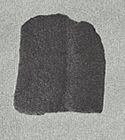 |
2 | Used for daily tasks like making arrow shafts straight for bows and arrows | These tools are typical at Upper Mississippian sites. |
| Antler | Antler projectile points; socketed and tanged | 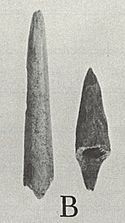 |
3 | Used for hunting, fishing, or fighting | The barbed type is often found with the Fisher culture, while the unbarbed type is more common with Oneota. |
| Bone | Deer skull spoon or scoop | 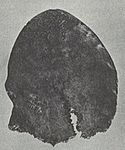 |
1 | Used for daily tasks, probably for preparing or serving food | This artifact is quite rare and hasn't been reported at other nearby sites. |
| Bone | Deer cannon bone beamer |  |
1 | Used for daily tasks, especially for working with animal hides | This tool is commonly found at Fisher and Langford sites. |
| Bone | Scapula hoes | 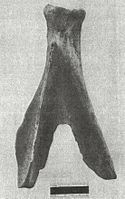 |
5 (4 from elk shoulder blades, one from a bison shoulder blade) | Used for daily tasks like farming, gardening, or general digging | These hoes are common at Fisher and Oneota sites. They might have been used to dig the pit features found at Griesmer. |
| Bone | Scapula knife or scraper | 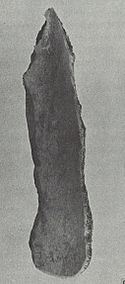 |
2 | Used for daily tasks like cutting | This artifact has been found at other sites in the Midwest, especially Illinois. It's sometimes called a "knife," "scraper," "spade," or "celt." |
| Bone | Bone beads |  |
3 | Used for personal decoration or ceremonies | These beads are common at Upper Mississippian sites. They might have been worn as jewelry or as part of special outfits for ceremonies. |
| Bone | Bone cylinders / game pieces |  |
5 | Used for entertainment | These have been found at Fisher, Huber, Langford, and Oneota sites. They may have been used in gambling games, which were popular among early Native American tribes. |
| Stone | Turtle-head effigy pipe fragment |  |
1 | Used for ceremonies or recreation (pipe smoking) | Pipes shaped like animals are not common among Upper Mississippian cultures. This pipe might have been traded from another group. They are common at Whittlesey sites in Ohio and have been found at the Late Woodland Dumaw Creek site in Michigan. |
Ancient Pottery: Clues to Cultures
The broken pieces of pottery found at Griesmer are very important. Different cultures made pottery in different ways, so the style of pottery can help archaeologists identify which groups lived at the site and when.
Middle Woodland Pottery
A small amount of pottery from the Middle Woodland period was found. Most of this pottery was called Havana Ware. The Havana Culture was a local group related to the larger Adena and Hopewell cultures. These larger cultures were known for their big burial mounds, unique pottery, special ceremonies, farming, and wide-ranging trade networks.
Late Woodland Pottery
The Late Woodland period in the Great Lakes region saw big changes. People started growing maize (corn), which meant they could produce more food. This led to more people living in the area, but also more competition for resources, which sometimes caused conflicts.
Only a few pieces of pottery from the Late Woodland period were found at Griesmer. This means Late Woodland people might have visited the site briefly at some point between 500 A.D. and the arrival of Europeans after 1600 A.D.
Upper Mississippian Pottery
The main group of people who lived at the Griesmer site were from the Upper Mississippian period. Two special dates from the site, 1520 A.D. and 1530 A.D., show that people were living there just before Europeans arrived in North America.
After 1000 A.D., cultures in the Great Lakes region were greatly influenced by the powerful Mississippian cultures from the Mississippi River Valley. Archaeologists call these influenced local groups "Upper Mississippians." Some of these cultures include the Oneota complex, which has different related groups.
The most common types of pottery found at Griesmer were Fisher and Huber Ware. These are either considered part of the Oneota complex or are very closely related to it. In 1972, an archaeologist named Charles Faulkner studied the pottery from Griesmer and other nearby sites to create a detailed way to describe these two pottery types.
Fisher Ware Pottery
Fisher Ware pottery was first identified at the Fisher Mound site in northeastern Illinois. It has also been found at other sites like Anker, Boumanville, and the Fifield site in Indiana.
This pottery is special because it uses crushed shell mixed into the clay (called "tempering") to make it stronger. Most pieces have a rough, cord-marked surface. They are often decorated with lines made by dragging a tool (trailed) or scratching (incised) into the clay. The rims (tops) of the pots can be straight, curved outwards, or flared. Notched lips (the very edge of the rim) and handles (lugs) are also common.
Two specific types of Fisher Ware were found at Griesmer:
- Fifield Trailed: (13 vessels) This pottery has trailed horizontal or vertical lines over smooth or cord-marked surfaces. Often, small dots (punctates) are used to create patterns with the lines. Notched or crimped lips are also common.
- Fifield Bold: (3 vessels) This type has bold, vertical lines made by fingers dragged across a cord-marked surface.
Huber Ware Pottery
Huber Ware pottery is found at many sites near Chicago, Illinois, like Huber, Anker, Oak Forest, and Hoxie Farm. It's also found in southwestern Michigan at sites like Moccasin Bluff and Schwerdt. At the Oak Forest site, Huber Ware was found with early European objects, meaning it was still being made when Europeans first arrived. We don't know for sure which Native American tribe made this pottery, but some experts think it might have been the Miami or Potawatomi tribes.
Huber Ware also uses shell for tempering. Most pieces have smooth surfaces, either plain or decorated with fine, vertical scratched lines. The rims usually curve outwards or flare. Fine notches on the lip are common. Some pots have strap handles or loops. Interestingly, some pieces found at Griesmer were from "coranders" (colanders), which are very rare pots with holes in them, likely for draining food. Most of these corander pieces were Huber Ware. Small, miniature pots were also found, and most of these were Huber Ware too.
Four specific types of Huber Ware were found at Griesmer:
- Huber Plain: (2 vessels) These pots have plain, smooth surfaces. The only decoration is usually notched lips.
- Huber Cordmarked: (4 vessels) These pots have cord-marked shoulders and bodies, and notched or cord-marked lips. They are similar to Fisher Cordmarked, but with small differences in how they were made and how the cord-marked surface looks. Huber Cordmarked surfaces are also more often smoothed over.
- Huber Trailed: (12 vessels) These pots have smooth surfaces with fine trailed or scratched lines. The lines are usually vertical or slant to the right.
- Huber Bold: This type was identified only from body pieces, not rims. The lines are made by fingers and mostly appear to have been vertical.
Why the Griesmer Site is Important
The Griesmer site is a very important prehistoric site because it shows us a lot about the Upper Mississippian people. The Fisher and Huber pottery, along with the radiocarbon dates, tell us that people lived at this site almost up to the time Europeans arrived.
Archaeologists believe that the Griesmer site was a short-term camp, not a permanent village where people farmed all year. They think people stayed there from late spring to early summer. A similar short-term camp was found at the Schwerdt site in Michigan. Schwerdt also had deep roasting pits with water lily plants and sturgeon fish bones. The pottery at Schwerdt was similar to Huber Ware.
Even though we can't say for sure which specific Native American tribes made the Fisher and Huber pottery at Griesmer, the Potawatomi and Miami tribes were in this area during early historic times. So, it's possible they were the descendants of the people who lived at Griesmer.



